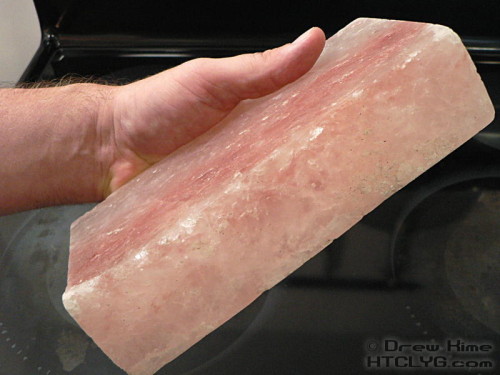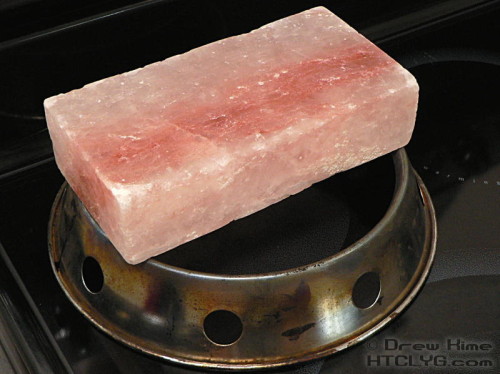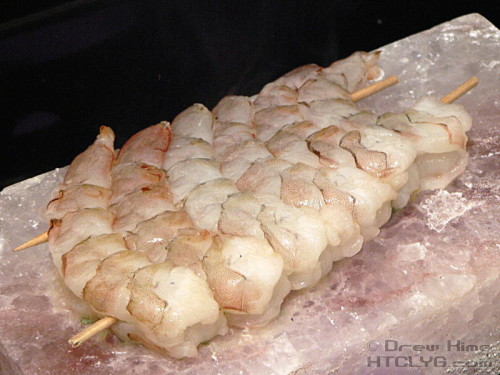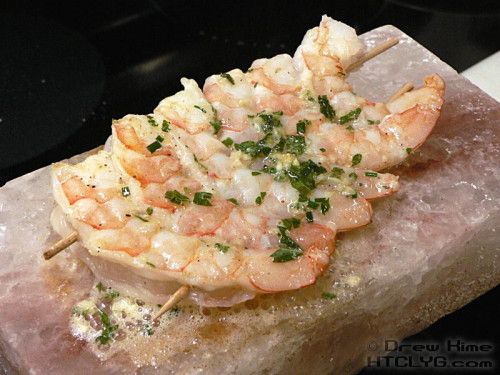“Himalayan salt block? Excuse me?”
Yes, I know, that’s what I was thinking. So let me start by telling you what it is: A solid block of salt carved out of a mine in Pakistan. And you can cook on it.
I’ll give you the negatives right off the bat: It takes at least a half-hour to warm the brick up enough to cook on it. Then once it’s hot you can’t just keep it on the burner and use it again and again.
Second, it’s really heavy, and really smooth, without any handles or knobs or bumps to grab on to with tongs to try to move it while it’s hot.
But for the little bit that you can cook on it in one go, the performance is really nice. It adds a bit of saltiness and is completely non-stick. Well … the food does stick to it, but if there’s any moisture at all in it, it will dissolve a layer of salt and release.
The block I was sent was the 4 x 8 x 2-inch premium cookware grade, and was more than 6 pounds.
This currently sells for $22, which sounds like a lot for a very limited-use cooking tool, but this is about presentation, too. And considering how much people spend on nice platters, that’s not too bad.
If you want to cook on it, you need a wok ring or something similar that will hold the block at least a half-inch above the burner.
This ring was actually much higher than I needed, but it’s all I had. A lower ring — or a gas burner — would probably have heated the brick up much faster.
Once it was up to temperature, I put the shrimp scampi on it.
It started sizzling right away, just like it’s supposed to. But when I brushed more melted butter on top, it started running down the side and dripping on the burner. And ignited.
Maybe on a gas cooktop I wouldn’t have even noticed the flames, or if I had noticed I wouldn’t have cared. But electric cooktops aren’t supposed to generate open flames.
So I pulled the ring forward, off the hot burner. I had started on the back burner, just in case anything went wrong. Score one for paranoia. This is when I realized I had no way to pick the block up and move it from the ring. I had nothing that I could grip it with.
So I crossed my fingers and hoped it would retain enough heat to do three sets of shrimp. The first one was perfect after a couple of minutes on each side.
The next two sets I started on the salt, but had to finish in a pan. So now I know: The brick holds enough heat to do one batch of whatever fits on top of it. And you don’t want anything really thick. And definitely let it come to room temperature before placing it on the salt. (Though you should be letting your meat come to room temperature before cooking no matter what you’re cooking them on.)
Next time I use this, I’ll have to plan ahead a little better. I need something that I can grab it with while it’s still hot, and something I can place it on to bring it to the table. A wooden cutting board should work just fine.
One unexpected bonus: After cooking the shrimp, the salty, herb-ey, melted butter on top of the salt was still bubbling. I dipped some bread in it and had instant garlic bread. Instant really, really good garlic bread. Some night I’m going to do pasta, and for the bread I’ll take some crusty Italian, butter it, and lay it face-down on the hot brick and bring it to the table like that.
The guide I got with my shipment also included directions for several cold preparations, like sashimi and Gravlax. Or you can put it in your grill, which means you can do thicker cuts, like a ribeye … hmm, do we have dinner plans yet for tonight?
Mmmm … grilled ribeye on a salt block …
Oops, sorry. I was having “a moment”. Where was I? Oh, right, where can you get one? That would be in my store.
















